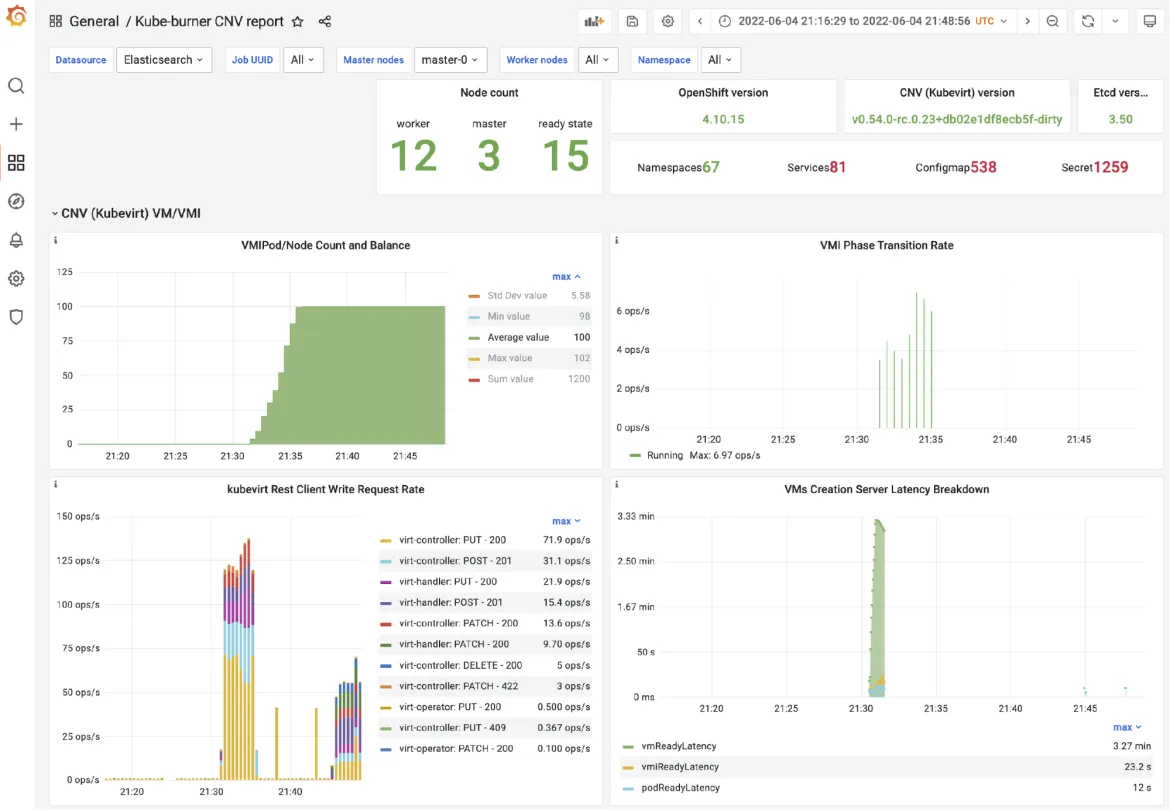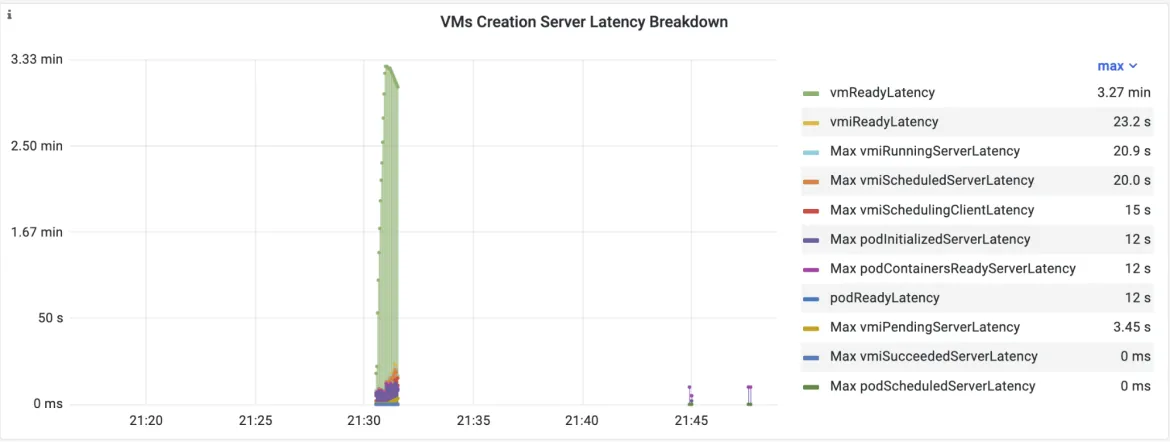This blog post is dedicated to explaining the tool used by the OpenShift Performance and Scale team (Performance and Scalability) to test the performance and scalability of OpenShift CNV and plain KubeVirt.
Wait, what are OpenShift CNV and KubeVirt?
KubeVirt is a virtual machine management add-on for Kubernetes intended to allow users to run VMs alongside containers in their Kubernetes cluster. Through the use of Custom Resource Definitions (CRDs) and other Kubernetes features, KubeVirt seamlessly extends existing Kubernetes. OpenShift Virtualization is an add-on to OpenShift Container Platform that is built on top of KubeVirt.
The two most important CRDs are the VirtualMachine (VM) and the VirtualMachineInstance (VMI). The VM object behaves in a way that is familiar to users who have managed virtual machines on AWS, GCE, OpenStack, IBM Cloud, etc. Users can shut down a VM and then choose to start that same VM again at a later time. In many ways a VM is very similar to a Kubernetes StatefulSet. A VM is layered on top of a VMI, which is the lowest-level unit at the bottom of the KubeVirt stack. A VMI defines all the properties of the virtual machine, such as CPU type, amount of RAM and vCPUs, etc.
Why use kube-burner?
Kube-burner is a tool officially designed and used to stress different components of OpenShift, coordinating the creation and deletion of k8s resources. While kube-burner is designed to be compatible with vanilla Kubernetes and OpenShift, by default (as expected) there is no support for third-party add-ons such as KubeVirt's custom resource definitions (CRDs).
Therefore, we extended the kube-burner to support KubeVirt CRDs, enabling cluster benchmarking by creating VMs alongside pods.
A previous blog post has already delved into how kube-burner works, so in this blog we will provide a high-level introduction and focus on the extensions that allow you to create VMs.
How does a kube-burner work?
Kube-burner is configured by YAML configuration files, where these files describe the different actions to be performed on the cluster, such as deleting or creating objects, as well as collecting Prometheus metrics.
For example, a simple configuration file might look like this:
global:
# collect metrics from Prometheus and dump to files
writeToFile: true
metricsDirectory: collected-metrics
measurements:
- name: vmLatency
jobs:
# create the VMs
- name: kubevirt-density
jobType: create
jobIterations: 1
qps: 20
burst: 20
namespace: kubevirt-density
# verify object count after running each job
verifyObjects: true
errorOnVerify: true
# interval between jobs execution
jobIterationDelay: 1s
# wait all VMI be in the Ready Condition
waitFor: ["VirtualMachine"]
waitWhenFinished: true
# timeout time after waiting for all object creation
maxWaitTimeout: 1h
jobPause: 10m
# cleanup cleans previous execution (not deleted or failed)
cleanup: true
objects:
- objectTemplate: templates/vm-ephemeral.yml
replicas: 1
Creating or deleting thousands of objects
Using a benchmarking tool like kube-burner make it easy to create or delete thousands of objects defined in a configuration file.
Within kube-burner there is the concept of Query Per Second (QPS) and Burst, which define the object creation and deletion rate. VerifyObjects will fail the job if the desired number of replicas are not created in the cluster within the maxWaitTimeout interval. Cleanup is often important to delete objects created in the previous run if there is no intention to keep them in the test. Finally, the waiFor parameter defines a list of objects waiting to be in the Ready state, that is, they have been created and are running.
Since kube-burner allows users to pass variables to object models as inputVars parameters, we can define custom models for different VM objects. For example, we can use these resources to create the following model:
apiVersion: kubevirt.io/v1
kind: VirtualMachine
metadata:
labels:
kubevirt.io/os: {{.OS}}
name: {{.name}}-{{.Replica}}
spec:
running: {{.createVMI}}
template:
metadata:
labels:
kubevirt.io/os: {{.OS}}
spec:
domain:
cpu:
cores: {{.cpuCores}}
devices:
disks:
- disk:
bus: virtio
name: cloudinitdisk
- disk:
bus: virtio
name: containerdisk
resources:
requests:
memory: {{.memory}}
volumes:
- containerDisk:
image: {{.image}}
imagePullPolicy: IfNotPresent
name: containerdisk
Where the previous configuration would be:
[...]
jobs:
[...]
objects:
- objectTemplate: templates/vm-ephemeral.yml
replicas: 1
inputVars:
name: kubevirt-density
image: quay.io/kubevirt/fedora-with-test-tooling-container-disk:v0.48.1
OS: fedora27
cpuCores: 1
memory: 4G
createVMI: true
Collecting Prometheus metrics
Kube-burner has a metrics collection mechanism that queries Prometheus and saves metrics to disk (in json files form) or indexes in external databases, currently ElasticSearch is the only supported one.
Prometheus queries are defined in a metric profile configuration file as shown below:
# Kubevirt metrics
- query: histogram_quantile(0.95, sum(rate(kubevirt_vmi_phase_transition_time_from_creation_seconds_bucket{}[5m])) by (phase, le))
metricName: vmi95thCreationLatency
# Containers & pod metrics
- query: sum(irate(container_cpu_usage_seconds_total{name!=""}[2m]) * 100) by (pod, namespace, node)
metricName: podCPU
To view these metrics, we can process Grafana to query the indexed metric in ElasticSearch or Prometheus.
Custom latency metrics
As kube-burner observes objects to check their states (for example, if a VM is in a Ready condition or if a VMI is in the execution phase), it is also possible to collect state transition latency from objects. As a curious factor, the implementation of such latency metrics in kune-burner for VMs inspired the implementation of similar metrics in the KubeVirt code.As shown earlier in the main configuration file, there is the measurement parameter which can be podLatency or vmLatency, where the names are self-explanatory. The vmLatency watches the VM, VMI, and pod objects and calculates state transition latency for all of them. Note that these latency metrics are not exported to Prometheus, but saved in json files or indexed in ElasticSearch.
For example, the vmLatency metric created by kube-burner is shown in the figure below:
Starting with kube-burner
Visit the github repository and check out a complete example configuration files (https://github.com/cloud-bulldozer/kube-burner). In addition to all of this, kube-kuber has other cool features like object verification and golang pprof collection.
Anyone interested in benchmarking a Kubernetes or OpenShift cluster by creating and deleting a large number of VMs can follow the steps listed in this blog and play with kube-burner to create node density tests.
You can also find a detailed kube-burner documentation in its readthedocs site.
執筆者紹介
類似検索
チャンネル別に見る
自動化
テクノロジー、チームおよび環境に関する IT 自動化の最新情報
AI (人工知能)
お客様が AI ワークロードをどこでも自由に実行することを可能にするプラットフォームについてのアップデート
オープン・ハイブリッドクラウド
ハイブリッドクラウドで柔軟に未来を築く方法をご確認ください。
セキュリティ
環境やテクノロジー全体に及ぶリスクを軽減する方法に関する最新情報
エッジコンピューティング
エッジでの運用を単純化するプラットフォームのアップデート
インフラストラクチャ
世界有数のエンタープライズ向け Linux プラットフォームの最新情報
アプリケーション
アプリケーションの最も困難な課題に対する Red Hat ソリューションの詳細
オリジナル番組
エンタープライズ向けテクノロジーのメーカーやリーダーによるストーリー
製品
ツール
試用、購入、販売
コミュニケーション
Red Hat について
エンタープライズ・オープンソース・ソリューションのプロバイダーとして世界をリードする Red Hat は、Linux、クラウド、コンテナ、Kubernetes などのテクノロジーを提供しています。Red Hat は強化されたソリューションを提供し、コアデータセンターからネットワークエッジまで、企業が複数のプラットフォームおよび環境間で容易に運用できるようにしています。
言語を選択してください
Red Hat legal and privacy links
- Red Hat について
- 採用情報
- イベント
- 各国のオフィス
- Red Hat へのお問い合わせ
- Red Hat ブログ
- ダイバーシティ、エクイティ、およびインクルージョン
- Cool Stuff Store
- Red Hat Summit




